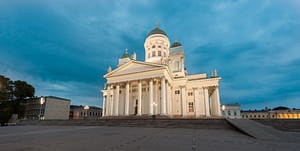The culture in Finland is largely shaped by it’s history. For years, the Swedes and Russians battled over control of the land, and, in the process, influenced the language and customs, especially in the regions of Ostrobothnia and Aland. Despite its colonizers, the Finnish language most closely resembles Hungarian. The northern outskirts of the country (Lapland) are dominated by the Sámi culture where people still follow a semi-nomadic lifestyle. Often dubbed Finland’s greatest contribution to the world, saunas are one of the most prevalent traditions in the country.
Finland became an important center for trade during the Viking Age, and while the Vikings chose not to establish settlements in this territory, Finland became a backdrop for occasional wars between quarreling neighbors like the Swedes, Germans and Russians. The provisions of the Treaty of Pahkinasaari (1323) divided Finland between Sweden and Russia.
The struggle for power between the two persisted for centuries, but Finns were keen to preserve their own culture, language and institutions. The year 1917 established Finland as an autonomous region, although still under the Russian Empire. The Finns declared independence after the Bolshevik Revolution, but the new state immediately faced civil war between social classes—the White Forces (property owners) and the Red Forces (landless farm, factory and forest workers).
The collapse of the Soviet Union led to the inclusion of Finland in the European Union. Today, they enjoy consistently high economic status thanks to its booming technology sector and steadily growing tourism industry.
The Finnish culture is a mix of indigenous heritage, Nordic and European influences. Differences in customs and traditions can be observed in the country’s various regions. There are Sami, Romani, Swedish-speaking Finns, Tartar, and the Jews, all of which have maintained their unique cultural identities. This melting pot can be observed in festivals, literature, visual arts, music, cinema, and even cuisine.
Finnish artists and architects have made major contributions to industrial design and sculpture. Finns are also very musical people, with rich folk traditions, such as Sami Music, often used to express beliefs and myths. Locals enjoy classical and opera music, with the country boasting popular works like Kullervo and Finlandia by Jean Sibellus. Pop and heavy metal entered the scene as Finland established closer relations with its Nordic neighbors, which coincided with a surge in musical acts, rock bands, dance music, and hip hop.
Thanks to European and Western influences, a rich culinary tradition has begun developing in Finland. Modern Finnish cooking is giving new flavor to usual staples like fish, vegetables, meat, and berries. In Lapland and the Lakeland areas, reindeer and seafood are the most common menu items.
Festivities and traditions in Finland are closely tied to the Christian Calendar, as well as to different protestant and pagan holidays. Midsummer and Christmas events are widely celebrated, along with Vappu/May Day, which is as close as you can get to Mardi Gras in Finland. The ubiquitous sauna bath is also a permanent fixture in daily Finnish life.

